Organizational Behavior Analysis: Toyota Motor Corporation Report
VerifiedAdded on 2019/12/28
|14
|4805
|298
Report
AI Summary
This report provides a comprehensive analysis of organizational behavior within Toyota Motor Corporation. It begins by comparing and contrasting Toyota's organizational structure and culture with Ford Motor Company, highlighting how their structures and cultures influence performance. The report delves into the factors influencing individual behavior at Toyota, such as ability, personality, and workplace dynamics. It then examines the leadership styles employed by Toyota and Ford, focusing on democratic versus autocratic approaches, and how organizational theories underpin management practices at Toyota. Furthermore, the report investigates the impact of different leadership styles on employee motivation during periods of change, the application of motivational theories, and their usefulness for managers. Finally, it explores the nature of groups and teamwork within Toyota, considering factors that promote or inhibit effective teamwork and the impact of technology on team functioning. The report concludes with a synthesis of the key findings and implications for Toyota's organizational effectiveness.
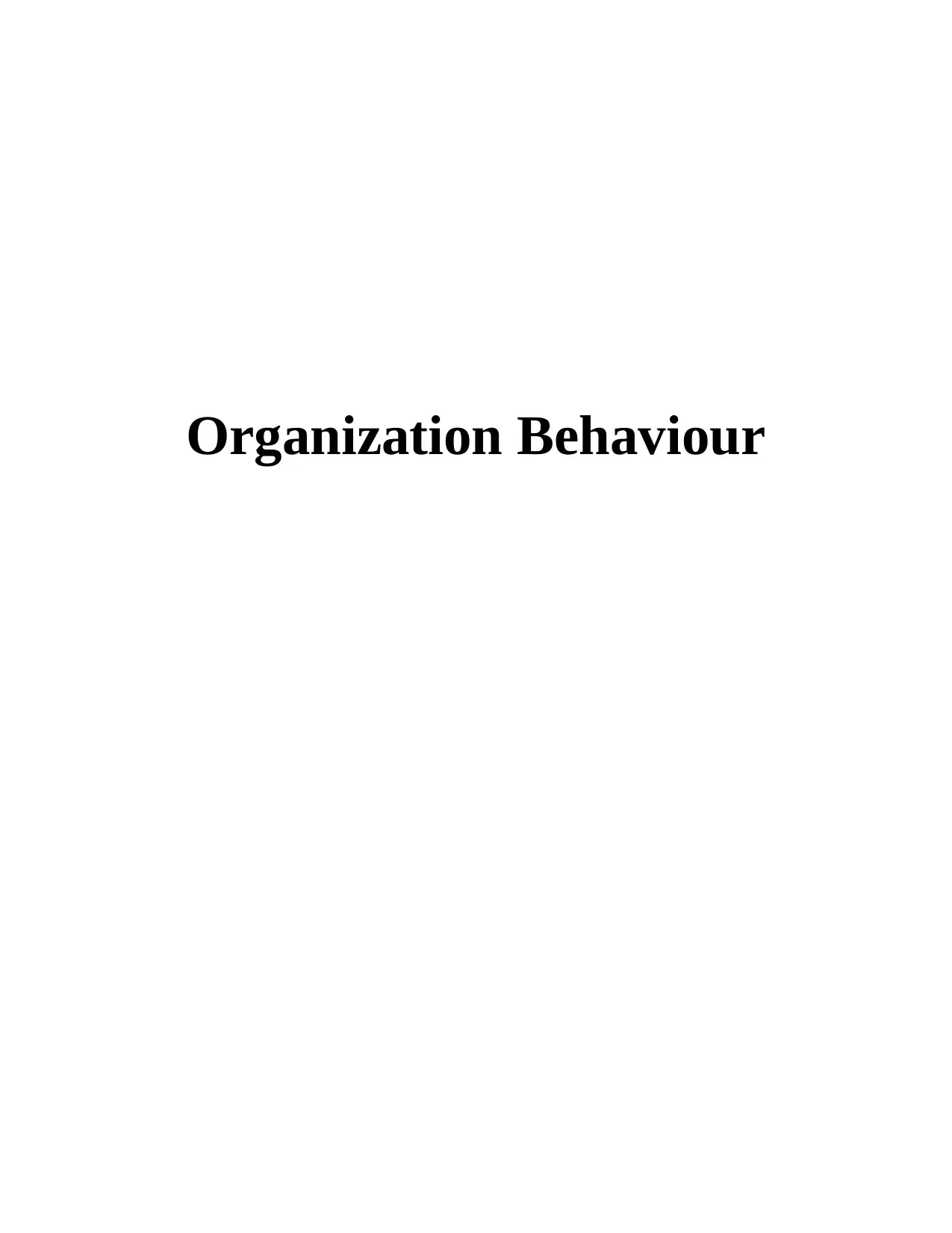
Organization Behaviour
Paraphrase This Document
Need a fresh take? Get an instant paraphrase of this document with our AI Paraphraser
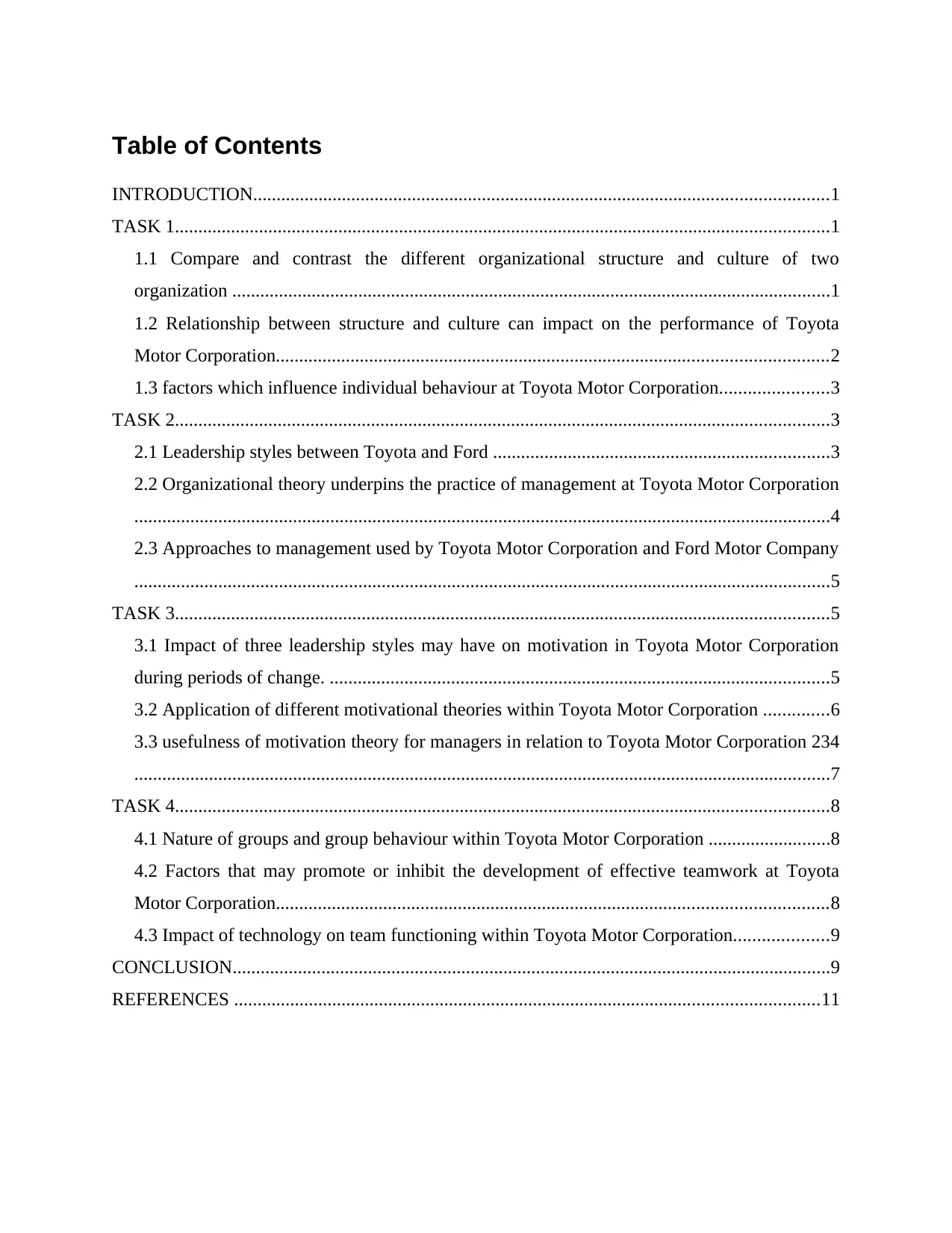
Table of Contents
INTRODUCTION...........................................................................................................................1
TASK 1............................................................................................................................................1
1.1 Compare and contrast the different organizational structure and culture of two
organization ................................................................................................................................1
1.2 Relationship between structure and culture can impact on the performance of Toyota
Motor Corporation......................................................................................................................2
1.3 factors which influence individual behaviour at Toyota Motor Corporation.......................3
TASK 2............................................................................................................................................3
2.1 Leadership styles between Toyota and Ford ........................................................................3
2.2 Organizational theory underpins the practice of management at Toyota Motor Corporation
.....................................................................................................................................................4
2.3 Approaches to management used by Toyota Motor Corporation and Ford Motor Company
.....................................................................................................................................................5
TASK 3............................................................................................................................................5
3.1 Impact of three leadership styles may have on motivation in Toyota Motor Corporation
during periods of change. ...........................................................................................................5
3.2 Application of different motivational theories within Toyota Motor Corporation ..............6
3.3 usefulness of motivation theory for managers in relation to Toyota Motor Corporation 234
.....................................................................................................................................................7
TASK 4............................................................................................................................................8
4.1 Nature of groups and group behaviour within Toyota Motor Corporation ..........................8
4.2 Factors that may promote or inhibit the development of effective teamwork at Toyota
Motor Corporation......................................................................................................................8
4.3 Impact of technology on team functioning within Toyota Motor Corporation....................9
CONCLUSION................................................................................................................................9
REFERENCES .............................................................................................................................11
INTRODUCTION...........................................................................................................................1
TASK 1............................................................................................................................................1
1.1 Compare and contrast the different organizational structure and culture of two
organization ................................................................................................................................1
1.2 Relationship between structure and culture can impact on the performance of Toyota
Motor Corporation......................................................................................................................2
1.3 factors which influence individual behaviour at Toyota Motor Corporation.......................3
TASK 2............................................................................................................................................3
2.1 Leadership styles between Toyota and Ford ........................................................................3
2.2 Organizational theory underpins the practice of management at Toyota Motor Corporation
.....................................................................................................................................................4
2.3 Approaches to management used by Toyota Motor Corporation and Ford Motor Company
.....................................................................................................................................................5
TASK 3............................................................................................................................................5
3.1 Impact of three leadership styles may have on motivation in Toyota Motor Corporation
during periods of change. ...........................................................................................................5
3.2 Application of different motivational theories within Toyota Motor Corporation ..............6
3.3 usefulness of motivation theory for managers in relation to Toyota Motor Corporation 234
.....................................................................................................................................................7
TASK 4............................................................................................................................................8
4.1 Nature of groups and group behaviour within Toyota Motor Corporation ..........................8
4.2 Factors that may promote or inhibit the development of effective teamwork at Toyota
Motor Corporation......................................................................................................................8
4.3 Impact of technology on team functioning within Toyota Motor Corporation....................9
CONCLUSION................................................................................................................................9
REFERENCES .............................................................................................................................11
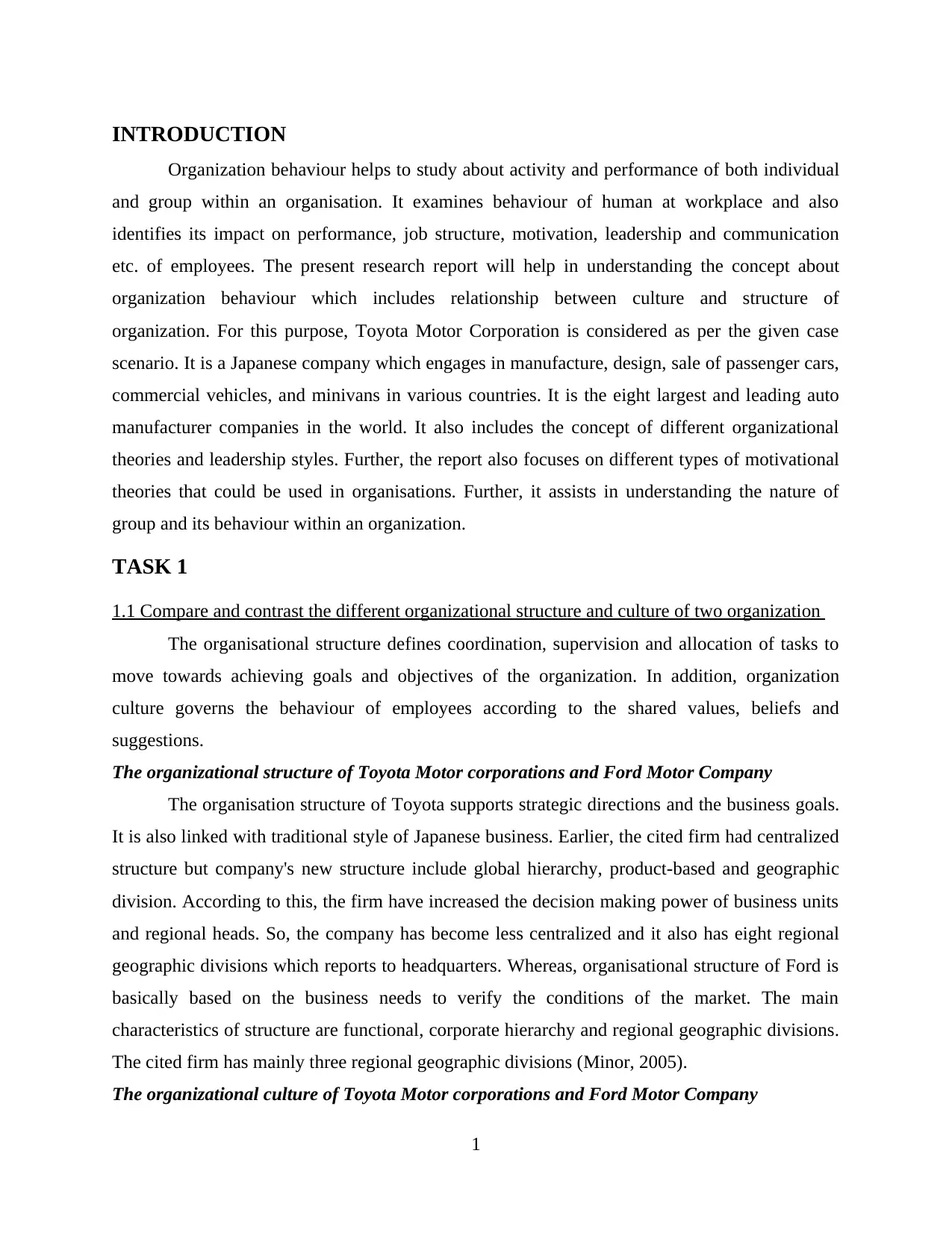
INTRODUCTION
Organization behaviour helps to study about activity and performance of both individual
and group within an organisation. It examines behaviour of human at workplace and also
identifies its impact on performance, job structure, motivation, leadership and communication
etc. of employees. The present research report will help in understanding the concept about
organization behaviour which includes relationship between culture and structure of
organization. For this purpose, Toyota Motor Corporation is considered as per the given case
scenario. It is a Japanese company which engages in manufacture, design, sale of passenger cars,
commercial vehicles, and minivans in various countries. It is the eight largest and leading auto
manufacturer companies in the world. It also includes the concept of different organizational
theories and leadership styles. Further, the report also focuses on different types of motivational
theories that could be used in organisations. Further, it assists in understanding the nature of
group and its behaviour within an organization.
TASK 1
1.1 Compare and contrast the different organizational structure and culture of two organization
The organisational structure defines coordination, supervision and allocation of tasks to
move towards achieving goals and objectives of the organization. In addition, organization
culture governs the behaviour of employees according to the shared values, beliefs and
suggestions.
The organizational structure of Toyota Motor corporations and Ford Motor Company
The organisation structure of Toyota supports strategic directions and the business goals.
It is also linked with traditional style of Japanese business. Earlier, the cited firm had centralized
structure but company's new structure include global hierarchy, product-based and geographic
division. According to this, the firm have increased the decision making power of business units
and regional heads. So, the company has become less centralized and it also has eight regional
geographic divisions which reports to headquarters. Whereas, organisational structure of Ford is
basically based on the business needs to verify the conditions of the market. The main
characteristics of structure are functional, corporate hierarchy and regional geographic divisions.
The cited firm has mainly three regional geographic divisions (Minor, 2005).
The organizational culture of Toyota Motor corporations and Ford Motor Company
1
Organization behaviour helps to study about activity and performance of both individual
and group within an organisation. It examines behaviour of human at workplace and also
identifies its impact on performance, job structure, motivation, leadership and communication
etc. of employees. The present research report will help in understanding the concept about
organization behaviour which includes relationship between culture and structure of
organization. For this purpose, Toyota Motor Corporation is considered as per the given case
scenario. It is a Japanese company which engages in manufacture, design, sale of passenger cars,
commercial vehicles, and minivans in various countries. It is the eight largest and leading auto
manufacturer companies in the world. It also includes the concept of different organizational
theories and leadership styles. Further, the report also focuses on different types of motivational
theories that could be used in organisations. Further, it assists in understanding the nature of
group and its behaviour within an organization.
TASK 1
1.1 Compare and contrast the different organizational structure and culture of two organization
The organisational structure defines coordination, supervision and allocation of tasks to
move towards achieving goals and objectives of the organization. In addition, organization
culture governs the behaviour of employees according to the shared values, beliefs and
suggestions.
The organizational structure of Toyota Motor corporations and Ford Motor Company
The organisation structure of Toyota supports strategic directions and the business goals.
It is also linked with traditional style of Japanese business. Earlier, the cited firm had centralized
structure but company's new structure include global hierarchy, product-based and geographic
division. According to this, the firm have increased the decision making power of business units
and regional heads. So, the company has become less centralized and it also has eight regional
geographic divisions which reports to headquarters. Whereas, organisational structure of Ford is
basically based on the business needs to verify the conditions of the market. The main
characteristics of structure are functional, corporate hierarchy and regional geographic divisions.
The cited firm has mainly three regional geographic divisions (Minor, 2005).
The organizational culture of Toyota Motor corporations and Ford Motor Company
1
⊘ This is a preview!⊘
Do you want full access?
Subscribe today to unlock all pages.

Trusted by 1+ million students worldwide
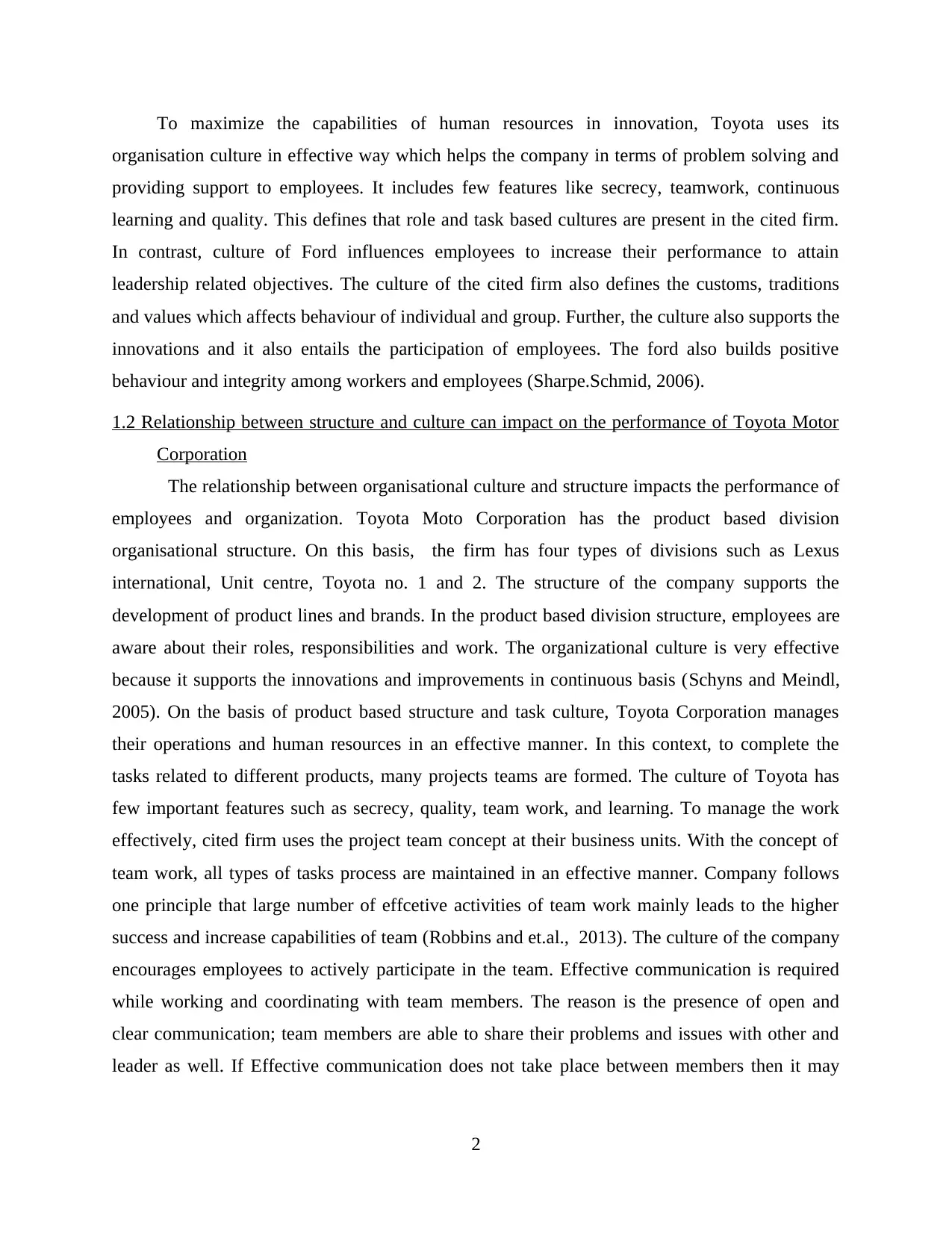
To maximize the capabilities of human resources in innovation, Toyota uses its
organisation culture in effective way which helps the company in terms of problem solving and
providing support to employees. It includes few features like secrecy, teamwork, continuous
learning and quality. This defines that role and task based cultures are present in the cited firm.
In contrast, culture of Ford influences employees to increase their performance to attain
leadership related objectives. The culture of the cited firm also defines the customs, traditions
and values which affects behaviour of individual and group. Further, the culture also supports the
innovations and it also entails the participation of employees. The ford also builds positive
behaviour and integrity among workers and employees (Sharpe.Schmid, 2006).
1.2 Relationship between structure and culture can impact on the performance of Toyota Motor
Corporation
The relationship between organisational culture and structure impacts the performance of
employees and organization. Toyota Moto Corporation has the product based division
organisational structure. On this basis, the firm has four types of divisions such as Lexus
international, Unit centre, Toyota no. 1 and 2. The structure of the company supports the
development of product lines and brands. In the product based division structure, employees are
aware about their roles, responsibilities and work. The organizational culture is very effective
because it supports the innovations and improvements in continuous basis (Schyns and Meindl,
2005). On the basis of product based structure and task culture, Toyota Corporation manages
their operations and human resources in an effective manner. In this context, to complete the
tasks related to different products, many projects teams are formed. The culture of Toyota has
few important features such as secrecy, quality, team work, and learning. To manage the work
effectively, cited firm uses the project team concept at their business units. With the concept of
team work, all types of tasks process are maintained in an effective manner. Company follows
one principle that large number of effcetive activities of team work mainly leads to the higher
success and increase capabilities of team (Robbins and et.al., 2013). The culture of the company
encourages employees to actively participate in the team. Effective communication is required
while working and coordinating with team members. The reason is the presence of open and
clear communication; team members are able to share their problems and issues with other and
leader as well. If Effective communication does not take place between members then it may
2
organisation culture in effective way which helps the company in terms of problem solving and
providing support to employees. It includes few features like secrecy, teamwork, continuous
learning and quality. This defines that role and task based cultures are present in the cited firm.
In contrast, culture of Ford influences employees to increase their performance to attain
leadership related objectives. The culture of the cited firm also defines the customs, traditions
and values which affects behaviour of individual and group. Further, the culture also supports the
innovations and it also entails the participation of employees. The ford also builds positive
behaviour and integrity among workers and employees (Sharpe.Schmid, 2006).
1.2 Relationship between structure and culture can impact on the performance of Toyota Motor
Corporation
The relationship between organisational culture and structure impacts the performance of
employees and organization. Toyota Moto Corporation has the product based division
organisational structure. On this basis, the firm has four types of divisions such as Lexus
international, Unit centre, Toyota no. 1 and 2. The structure of the company supports the
development of product lines and brands. In the product based division structure, employees are
aware about their roles, responsibilities and work. The organizational culture is very effective
because it supports the innovations and improvements in continuous basis (Schyns and Meindl,
2005). On the basis of product based structure and task culture, Toyota Corporation manages
their operations and human resources in an effective manner. In this context, to complete the
tasks related to different products, many projects teams are formed. The culture of Toyota has
few important features such as secrecy, quality, team work, and learning. To manage the work
effectively, cited firm uses the project team concept at their business units. With the concept of
team work, all types of tasks process are maintained in an effective manner. Company follows
one principle that large number of effcetive activities of team work mainly leads to the higher
success and increase capabilities of team (Robbins and et.al., 2013). The culture of the company
encourages employees to actively participate in the team. Effective communication is required
while working and coordinating with team members. The reason is the presence of open and
clear communication; team members are able to share their problems and issues with other and
leader as well. If Effective communication does not take place between members then it may
2
Paraphrase This Document
Need a fresh take? Get an instant paraphrase of this document with our AI Paraphraser
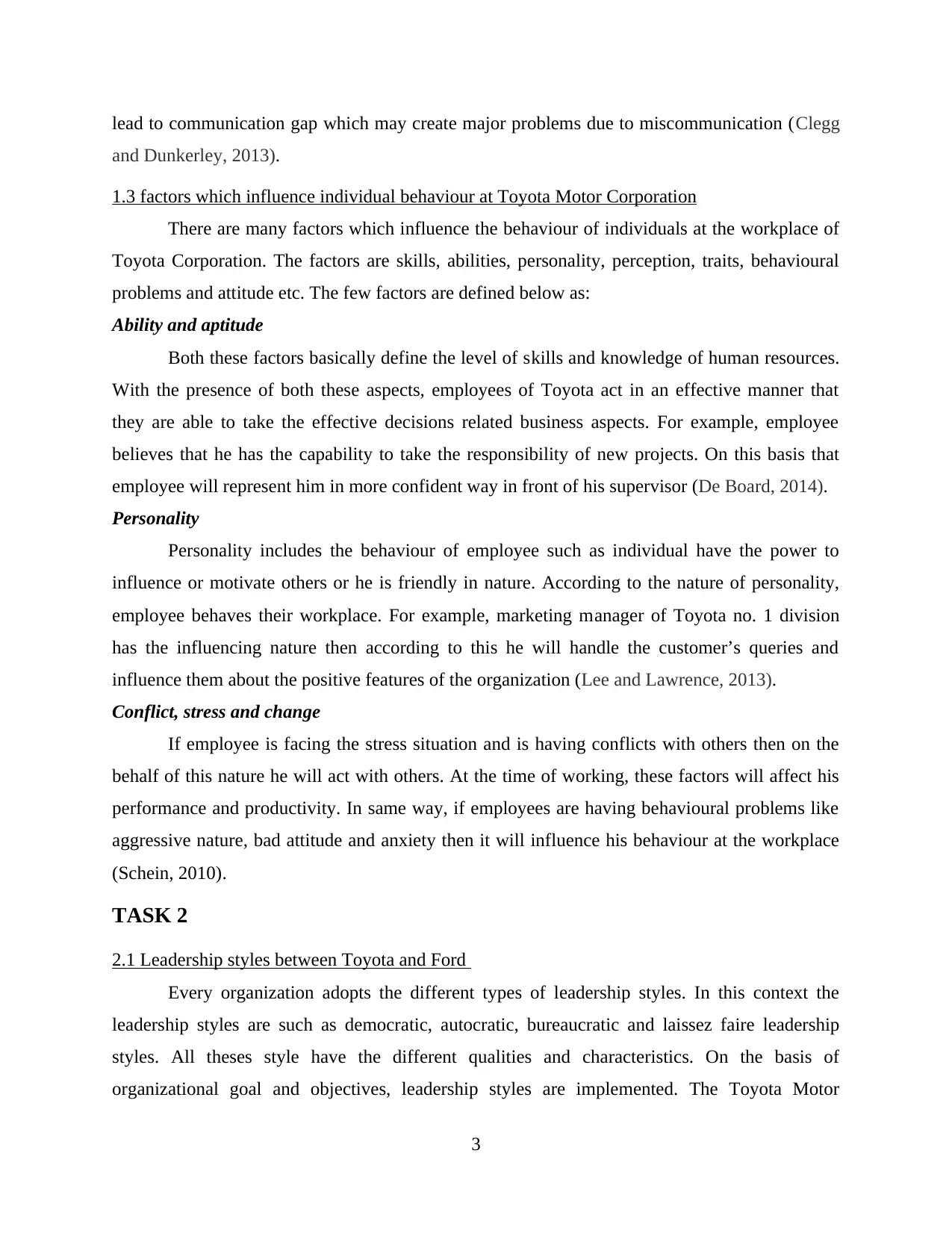
lead to communication gap which may create major problems due to miscommunication (Clegg
and Dunkerley, 2013).
1.3 factors which influence individual behaviour at Toyota Motor Corporation
There are many factors which influence the behaviour of individuals at the workplace of
Toyota Corporation. The factors are skills, abilities, personality, perception, traits, behavioural
problems and attitude etc. The few factors are defined below as:
Ability and aptitude
Both these factors basically define the level of skills and knowledge of human resources.
With the presence of both these aspects, employees of Toyota act in an effective manner that
they are able to take the effective decisions related business aspects. For example, employee
believes that he has the capability to take the responsibility of new projects. On this basis that
employee will represent him in more confident way in front of his supervisor (De Board, 2014).
Personality
Personality includes the behaviour of employee such as individual have the power to
influence or motivate others or he is friendly in nature. According to the nature of personality,
employee behaves their workplace. For example, marketing manager of Toyota no. 1 division
has the influencing nature then according to this he will handle the customer’s queries and
influence them about the positive features of the organization (Lee and Lawrence, 2013).
Conflict, stress and change
If employee is facing the stress situation and is having conflicts with others then on the
behalf of this nature he will act with others. At the time of working, these factors will affect his
performance and productivity. In same way, if employees are having behavioural problems like
aggressive nature, bad attitude and anxiety then it will influence his behaviour at the workplace
(Schein, 2010).
TASK 2
2.1 Leadership styles between Toyota and Ford
Every organization adopts the different types of leadership styles. In this context the
leadership styles are such as democratic, autocratic, bureaucratic and laissez faire leadership
styles. All theses style have the different qualities and characteristics. On the basis of
organizational goal and objectives, leadership styles are implemented. The Toyota Motor
3
and Dunkerley, 2013).
1.3 factors which influence individual behaviour at Toyota Motor Corporation
There are many factors which influence the behaviour of individuals at the workplace of
Toyota Corporation. The factors are skills, abilities, personality, perception, traits, behavioural
problems and attitude etc. The few factors are defined below as:
Ability and aptitude
Both these factors basically define the level of skills and knowledge of human resources.
With the presence of both these aspects, employees of Toyota act in an effective manner that
they are able to take the effective decisions related business aspects. For example, employee
believes that he has the capability to take the responsibility of new projects. On this basis that
employee will represent him in more confident way in front of his supervisor (De Board, 2014).
Personality
Personality includes the behaviour of employee such as individual have the power to
influence or motivate others or he is friendly in nature. According to the nature of personality,
employee behaves their workplace. For example, marketing manager of Toyota no. 1 division
has the influencing nature then according to this he will handle the customer’s queries and
influence them about the positive features of the organization (Lee and Lawrence, 2013).
Conflict, stress and change
If employee is facing the stress situation and is having conflicts with others then on the
behalf of this nature he will act with others. At the time of working, these factors will affect his
performance and productivity. In same way, if employees are having behavioural problems like
aggressive nature, bad attitude and anxiety then it will influence his behaviour at the workplace
(Schein, 2010).
TASK 2
2.1 Leadership styles between Toyota and Ford
Every organization adopts the different types of leadership styles. In this context the
leadership styles are such as democratic, autocratic, bureaucratic and laissez faire leadership
styles. All theses style have the different qualities and characteristics. On the basis of
organizational goal and objectives, leadership styles are implemented. The Toyota Motor
3
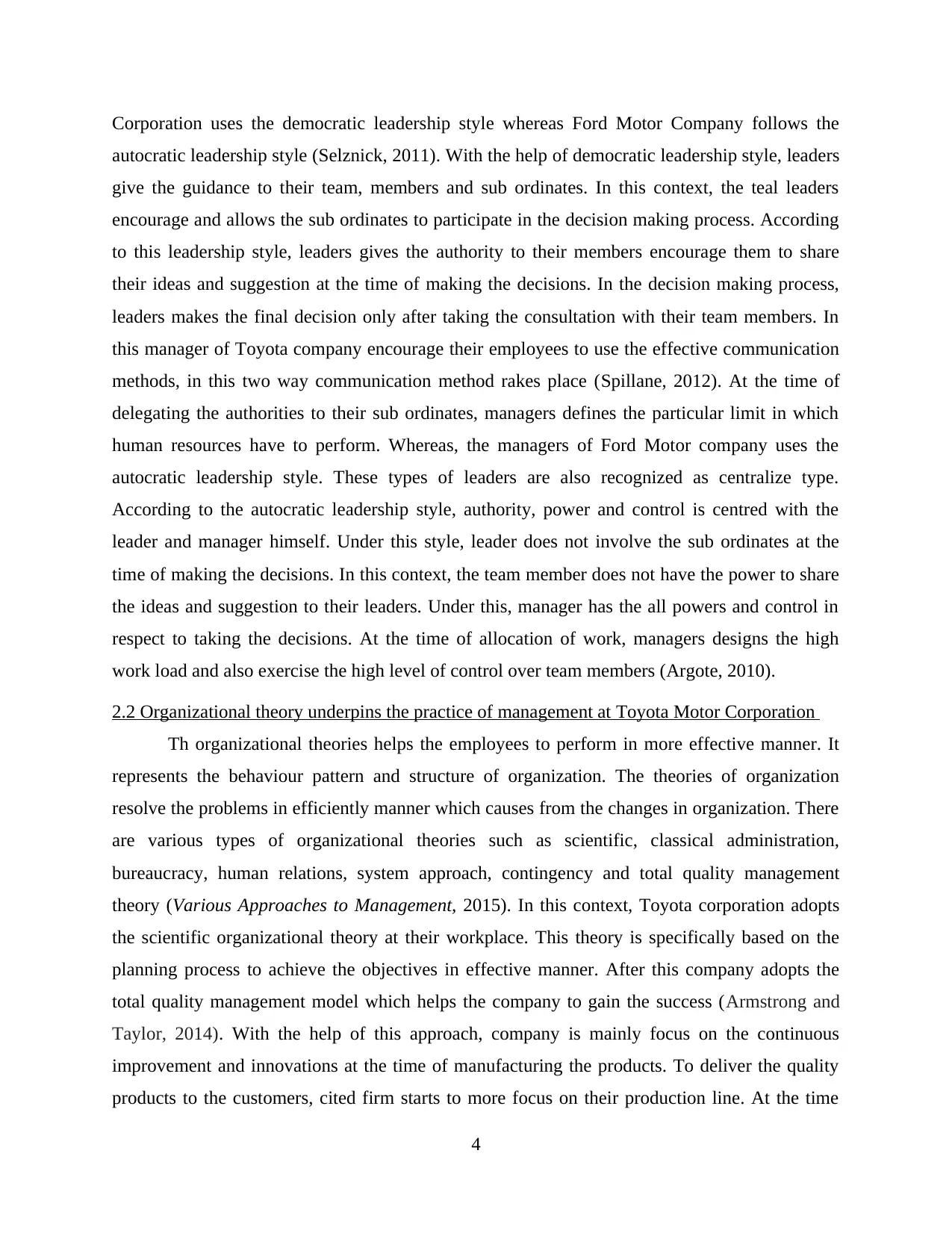
Corporation uses the democratic leadership style whereas Ford Motor Company follows the
autocratic leadership style (Selznick, 2011). With the help of democratic leadership style, leaders
give the guidance to their team, members and sub ordinates. In this context, the teal leaders
encourage and allows the sub ordinates to participate in the decision making process. According
to this leadership style, leaders gives the authority to their members encourage them to share
their ideas and suggestion at the time of making the decisions. In the decision making process,
leaders makes the final decision only after taking the consultation with their team members. In
this manager of Toyota company encourage their employees to use the effective communication
methods, in this two way communication method rakes place (Spillane, 2012). At the time of
delegating the authorities to their sub ordinates, managers defines the particular limit in which
human resources have to perform. Whereas, the managers of Ford Motor company uses the
autocratic leadership style. These types of leaders are also recognized as centralize type.
According to the autocratic leadership style, authority, power and control is centred with the
leader and manager himself. Under this style, leader does not involve the sub ordinates at the
time of making the decisions. In this context, the team member does not have the power to share
the ideas and suggestion to their leaders. Under this, manager has the all powers and control in
respect to taking the decisions. At the time of allocation of work, managers designs the high
work load and also exercise the high level of control over team members (Argote, 2010).
2.2 Organizational theory underpins the practice of management at Toyota Motor Corporation
Th organizational theories helps the employees to perform in more effective manner. It
represents the behaviour pattern and structure of organization. The theories of organization
resolve the problems in efficiently manner which causes from the changes in organization. There
are various types of organizational theories such as scientific, classical administration,
bureaucracy, human relations, system approach, contingency and total quality management
theory (Various Approaches to Management, 2015). In this context, Toyota corporation adopts
the scientific organizational theory at their workplace. This theory is specifically based on the
planning process to achieve the objectives in effective manner. After this company adopts the
total quality management model which helps the company to gain the success (Armstrong and
Taylor, 2014). With the help of this approach, company is mainly focus on the continuous
improvement and innovations at the time of manufacturing the products. To deliver the quality
products to the customers, cited firm starts to more focus on their production line. At the time
4
autocratic leadership style (Selznick, 2011). With the help of democratic leadership style, leaders
give the guidance to their team, members and sub ordinates. In this context, the teal leaders
encourage and allows the sub ordinates to participate in the decision making process. According
to this leadership style, leaders gives the authority to their members encourage them to share
their ideas and suggestion at the time of making the decisions. In the decision making process,
leaders makes the final decision only after taking the consultation with their team members. In
this manager of Toyota company encourage their employees to use the effective communication
methods, in this two way communication method rakes place (Spillane, 2012). At the time of
delegating the authorities to their sub ordinates, managers defines the particular limit in which
human resources have to perform. Whereas, the managers of Ford Motor company uses the
autocratic leadership style. These types of leaders are also recognized as centralize type.
According to the autocratic leadership style, authority, power and control is centred with the
leader and manager himself. Under this style, leader does not involve the sub ordinates at the
time of making the decisions. In this context, the team member does not have the power to share
the ideas and suggestion to their leaders. Under this, manager has the all powers and control in
respect to taking the decisions. At the time of allocation of work, managers designs the high
work load and also exercise the high level of control over team members (Argote, 2010).
2.2 Organizational theory underpins the practice of management at Toyota Motor Corporation
Th organizational theories helps the employees to perform in more effective manner. It
represents the behaviour pattern and structure of organization. The theories of organization
resolve the problems in efficiently manner which causes from the changes in organization. There
are various types of organizational theories such as scientific, classical administration,
bureaucracy, human relations, system approach, contingency and total quality management
theory (Various Approaches to Management, 2015). In this context, Toyota corporation adopts
the scientific organizational theory at their workplace. This theory is specifically based on the
planning process to achieve the objectives in effective manner. After this company adopts the
total quality management model which helps the company to gain the success (Armstrong and
Taylor, 2014). With the help of this approach, company is mainly focus on the continuous
improvement and innovations at the time of manufacturing the products. To deliver the quality
products to the customers, cited firm starts to more focus on their production line. At the time
4
⊘ This is a preview!⊘
Do you want full access?
Subscribe today to unlock all pages.

Trusted by 1+ million students worldwide
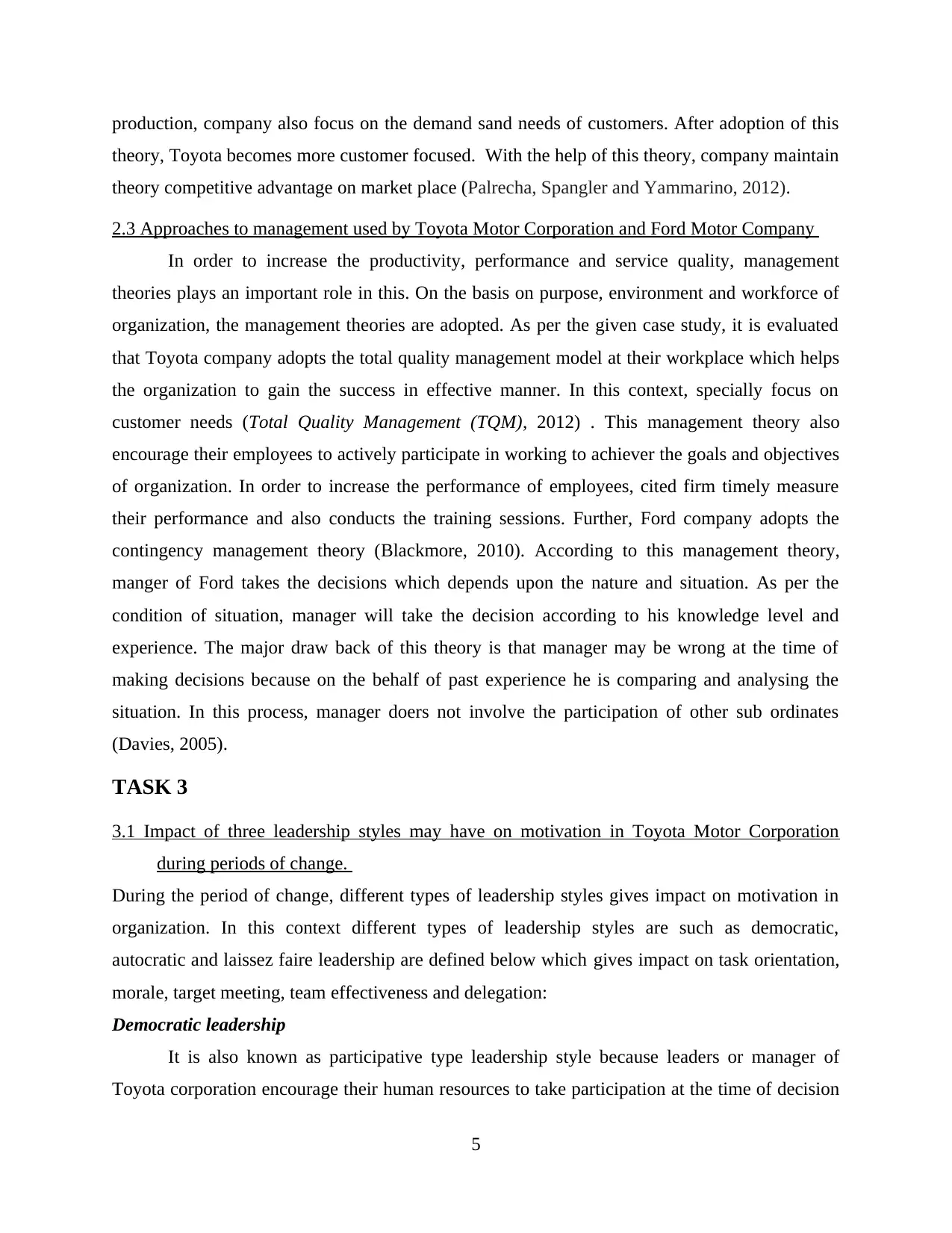
production, company also focus on the demand sand needs of customers. After adoption of this
theory, Toyota becomes more customer focused. With the help of this theory, company maintain
theory competitive advantage on market place (Palrecha, Spangler and Yammarino, 2012).
2.3 Approaches to management used by Toyota Motor Corporation and Ford Motor Company
In order to increase the productivity, performance and service quality, management
theories plays an important role in this. On the basis on purpose, environment and workforce of
organization, the management theories are adopted. As per the given case study, it is evaluated
that Toyota company adopts the total quality management model at their workplace which helps
the organization to gain the success in effective manner. In this context, specially focus on
customer needs (Total Quality Management (TQM), 2012) . This management theory also
encourage their employees to actively participate in working to achiever the goals and objectives
of organization. In order to increase the performance of employees, cited firm timely measure
their performance and also conducts the training sessions. Further, Ford company adopts the
contingency management theory (Blackmore, 2010). According to this management theory,
manger of Ford takes the decisions which depends upon the nature and situation. As per the
condition of situation, manager will take the decision according to his knowledge level and
experience. The major draw back of this theory is that manager may be wrong at the time of
making decisions because on the behalf of past experience he is comparing and analysing the
situation. In this process, manager doers not involve the participation of other sub ordinates
(Davies, 2005).
TASK 3
3.1 Impact of three leadership styles may have on motivation in Toyota Motor Corporation
during periods of change.
During the period of change, different types of leadership styles gives impact on motivation in
organization. In this context different types of leadership styles are such as democratic,
autocratic and laissez faire leadership are defined below which gives impact on task orientation,
morale, target meeting, team effectiveness and delegation:
Democratic leadership
It is also known as participative type leadership style because leaders or manager of
Toyota corporation encourage their human resources to take participation at the time of decision
5
theory, Toyota becomes more customer focused. With the help of this theory, company maintain
theory competitive advantage on market place (Palrecha, Spangler and Yammarino, 2012).
2.3 Approaches to management used by Toyota Motor Corporation and Ford Motor Company
In order to increase the productivity, performance and service quality, management
theories plays an important role in this. On the basis on purpose, environment and workforce of
organization, the management theories are adopted. As per the given case study, it is evaluated
that Toyota company adopts the total quality management model at their workplace which helps
the organization to gain the success in effective manner. In this context, specially focus on
customer needs (Total Quality Management (TQM), 2012) . This management theory also
encourage their employees to actively participate in working to achiever the goals and objectives
of organization. In order to increase the performance of employees, cited firm timely measure
their performance and also conducts the training sessions. Further, Ford company adopts the
contingency management theory (Blackmore, 2010). According to this management theory,
manger of Ford takes the decisions which depends upon the nature and situation. As per the
condition of situation, manager will take the decision according to his knowledge level and
experience. The major draw back of this theory is that manager may be wrong at the time of
making decisions because on the behalf of past experience he is comparing and analysing the
situation. In this process, manager doers not involve the participation of other sub ordinates
(Davies, 2005).
TASK 3
3.1 Impact of three leadership styles may have on motivation in Toyota Motor Corporation
during periods of change.
During the period of change, different types of leadership styles gives impact on motivation in
organization. In this context different types of leadership styles are such as democratic,
autocratic and laissez faire leadership are defined below which gives impact on task orientation,
morale, target meeting, team effectiveness and delegation:
Democratic leadership
It is also known as participative type leadership style because leaders or manager of
Toyota corporation encourage their human resources to take participation at the time of decision
5
Paraphrase This Document
Need a fresh take? Get an instant paraphrase of this document with our AI Paraphraser
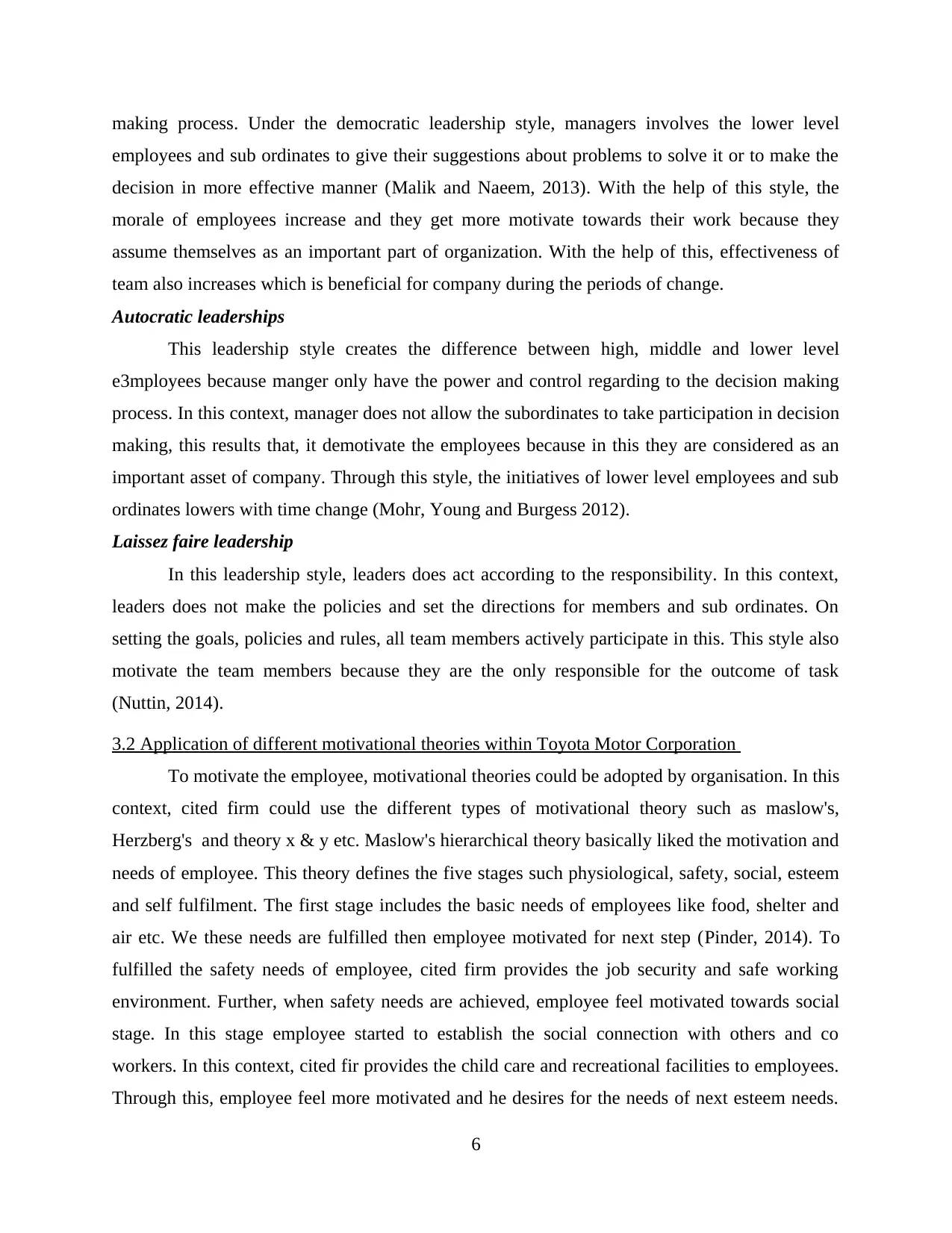
making process. Under the democratic leadership style, managers involves the lower level
employees and sub ordinates to give their suggestions about problems to solve it or to make the
decision in more effective manner (Malik and Naeem, 2013). With the help of this style, the
morale of employees increase and they get more motivate towards their work because they
assume themselves as an important part of organization. With the help of this, effectiveness of
team also increases which is beneficial for company during the periods of change.
Autocratic leaderships
This leadership style creates the difference between high, middle and lower level
e3mployees because manger only have the power and control regarding to the decision making
process. In this context, manager does not allow the subordinates to take participation in decision
making, this results that, it demotivate the employees because in this they are considered as an
important asset of company. Through this style, the initiatives of lower level employees and sub
ordinates lowers with time change (Mohr, Young and Burgess 2012).
Laissez faire leadership
In this leadership style, leaders does act according to the responsibility. In this context,
leaders does not make the policies and set the directions for members and sub ordinates. On
setting the goals, policies and rules, all team members actively participate in this. This style also
motivate the team members because they are the only responsible for the outcome of task
(Nuttin, 2014).
3.2 Application of different motivational theories within Toyota Motor Corporation
To motivate the employee, motivational theories could be adopted by organisation. In this
context, cited firm could use the different types of motivational theory such as maslow's,
Herzberg's and theory x & y etc. Maslow's hierarchical theory basically liked the motivation and
needs of employee. This theory defines the five stages such physiological, safety, social, esteem
and self fulfilment. The first stage includes the basic needs of employees like food, shelter and
air etc. We these needs are fulfilled then employee motivated for next step (Pinder, 2014). To
fulfilled the safety needs of employee, cited firm provides the job security and safe working
environment. Further, when safety needs are achieved, employee feel motivated towards social
stage. In this stage employee started to establish the social connection with others and co
workers. In this context, cited fir provides the child care and recreational facilities to employees.
Through this, employee feel more motivated and he desires for the needs of next esteem needs.
6
employees and sub ordinates to give their suggestions about problems to solve it or to make the
decision in more effective manner (Malik and Naeem, 2013). With the help of this style, the
morale of employees increase and they get more motivate towards their work because they
assume themselves as an important part of organization. With the help of this, effectiveness of
team also increases which is beneficial for company during the periods of change.
Autocratic leaderships
This leadership style creates the difference between high, middle and lower level
e3mployees because manger only have the power and control regarding to the decision making
process. In this context, manager does not allow the subordinates to take participation in decision
making, this results that, it demotivate the employees because in this they are considered as an
important asset of company. Through this style, the initiatives of lower level employees and sub
ordinates lowers with time change (Mohr, Young and Burgess 2012).
Laissez faire leadership
In this leadership style, leaders does act according to the responsibility. In this context,
leaders does not make the policies and set the directions for members and sub ordinates. On
setting the goals, policies and rules, all team members actively participate in this. This style also
motivate the team members because they are the only responsible for the outcome of task
(Nuttin, 2014).
3.2 Application of different motivational theories within Toyota Motor Corporation
To motivate the employee, motivational theories could be adopted by organisation. In this
context, cited firm could use the different types of motivational theory such as maslow's,
Herzberg's and theory x & y etc. Maslow's hierarchical theory basically liked the motivation and
needs of employee. This theory defines the five stages such physiological, safety, social, esteem
and self fulfilment. The first stage includes the basic needs of employees like food, shelter and
air etc. We these needs are fulfilled then employee motivated for next step (Pinder, 2014). To
fulfilled the safety needs of employee, cited firm provides the job security and safe working
environment. Further, when safety needs are achieved, employee feel motivated towards social
stage. In this stage employee started to establish the social connection with others and co
workers. In this context, cited fir provides the child care and recreational facilities to employees.
Through this, employee feel more motivated and he desires for the needs of next esteem needs.
6
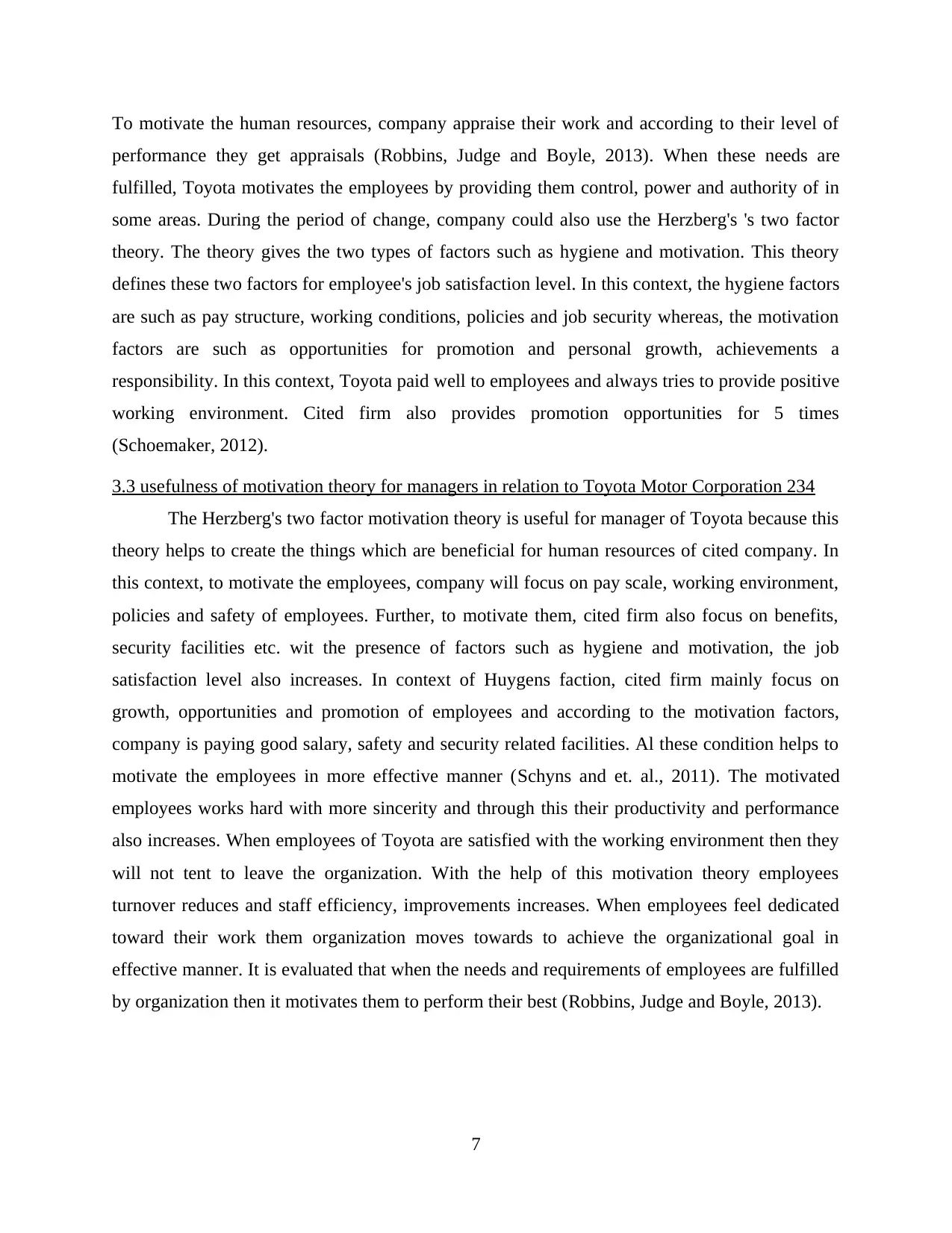
To motivate the human resources, company appraise their work and according to their level of
performance they get appraisals (Robbins, Judge and Boyle, 2013). When these needs are
fulfilled, Toyota motivates the employees by providing them control, power and authority of in
some areas. During the period of change, company could also use the Herzberg's 's two factor
theory. The theory gives the two types of factors such as hygiene and motivation. This theory
defines these two factors for employee's job satisfaction level. In this context, the hygiene factors
are such as pay structure, working conditions, policies and job security whereas, the motivation
factors are such as opportunities for promotion and personal growth, achievements a
responsibility. In this context, Toyota paid well to employees and always tries to provide positive
working environment. Cited firm also provides promotion opportunities for 5 times
(Schoemaker, 2012).
3.3 usefulness of motivation theory for managers in relation to Toyota Motor Corporation 234
The Herzberg's two factor motivation theory is useful for manager of Toyota because this
theory helps to create the things which are beneficial for human resources of cited company. In
this context, to motivate the employees, company will focus on pay scale, working environment,
policies and safety of employees. Further, to motivate them, cited firm also focus on benefits,
security facilities etc. wit the presence of factors such as hygiene and motivation, the job
satisfaction level also increases. In context of Huygens faction, cited firm mainly focus on
growth, opportunities and promotion of employees and according to the motivation factors,
company is paying good salary, safety and security related facilities. Al these condition helps to
motivate the employees in more effective manner (Schyns and et. al., 2011). The motivated
employees works hard with more sincerity and through this their productivity and performance
also increases. When employees of Toyota are satisfied with the working environment then they
will not tent to leave the organization. With the help of this motivation theory employees
turnover reduces and staff efficiency, improvements increases. When employees feel dedicated
toward their work them organization moves towards to achieve the organizational goal in
effective manner. It is evaluated that when the needs and requirements of employees are fulfilled
by organization then it motivates them to perform their best (Robbins, Judge and Boyle, 2013).
7
performance they get appraisals (Robbins, Judge and Boyle, 2013). When these needs are
fulfilled, Toyota motivates the employees by providing them control, power and authority of in
some areas. During the period of change, company could also use the Herzberg's 's two factor
theory. The theory gives the two types of factors such as hygiene and motivation. This theory
defines these two factors for employee's job satisfaction level. In this context, the hygiene factors
are such as pay structure, working conditions, policies and job security whereas, the motivation
factors are such as opportunities for promotion and personal growth, achievements a
responsibility. In this context, Toyota paid well to employees and always tries to provide positive
working environment. Cited firm also provides promotion opportunities for 5 times
(Schoemaker, 2012).
3.3 usefulness of motivation theory for managers in relation to Toyota Motor Corporation 234
The Herzberg's two factor motivation theory is useful for manager of Toyota because this
theory helps to create the things which are beneficial for human resources of cited company. In
this context, to motivate the employees, company will focus on pay scale, working environment,
policies and safety of employees. Further, to motivate them, cited firm also focus on benefits,
security facilities etc. wit the presence of factors such as hygiene and motivation, the job
satisfaction level also increases. In context of Huygens faction, cited firm mainly focus on
growth, opportunities and promotion of employees and according to the motivation factors,
company is paying good salary, safety and security related facilities. Al these condition helps to
motivate the employees in more effective manner (Schyns and et. al., 2011). The motivated
employees works hard with more sincerity and through this their productivity and performance
also increases. When employees of Toyota are satisfied with the working environment then they
will not tent to leave the organization. With the help of this motivation theory employees
turnover reduces and staff efficiency, improvements increases. When employees feel dedicated
toward their work them organization moves towards to achieve the organizational goal in
effective manner. It is evaluated that when the needs and requirements of employees are fulfilled
by organization then it motivates them to perform their best (Robbins, Judge and Boyle, 2013).
7
⊘ This is a preview!⊘
Do you want full access?
Subscribe today to unlock all pages.

Trusted by 1+ million students worldwide
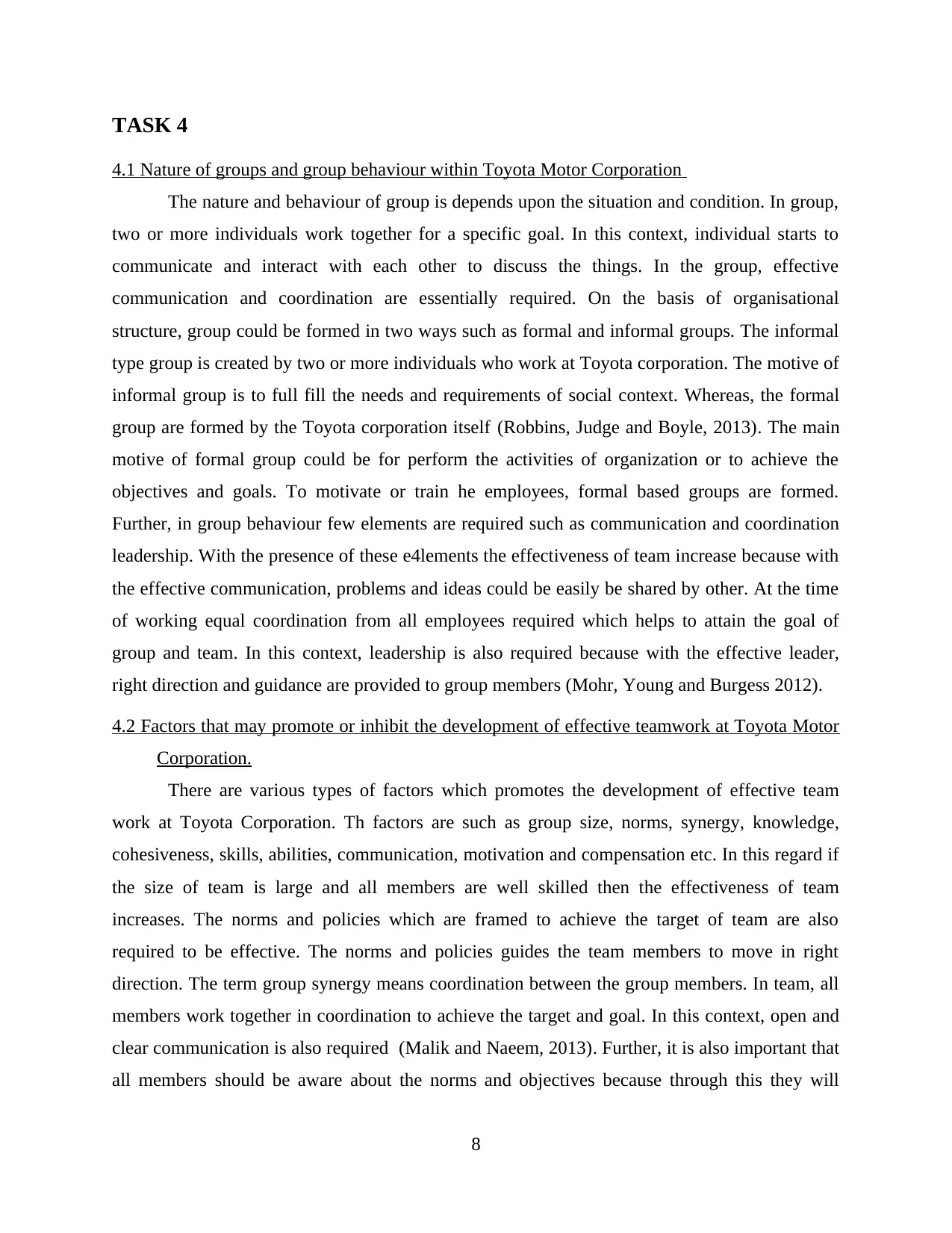
TASK 4
4.1 Nature of groups and group behaviour within Toyota Motor Corporation
The nature and behaviour of group is depends upon the situation and condition. In group,
two or more individuals work together for a specific goal. In this context, individual starts to
communicate and interact with each other to discuss the things. In the group, effective
communication and coordination are essentially required. On the basis of organisational
structure, group could be formed in two ways such as formal and informal groups. The informal
type group is created by two or more individuals who work at Toyota corporation. The motive of
informal group is to full fill the needs and requirements of social context. Whereas, the formal
group are formed by the Toyota corporation itself (Robbins, Judge and Boyle, 2013). The main
motive of formal group could be for perform the activities of organization or to achieve the
objectives and goals. To motivate or train he employees, formal based groups are formed.
Further, in group behaviour few elements are required such as communication and coordination
leadership. With the presence of these e4lements the effectiveness of team increase because with
the effective communication, problems and ideas could be easily be shared by other. At the time
of working equal coordination from all employees required which helps to attain the goal of
group and team. In this context, leadership is also required because with the effective leader,
right direction and guidance are provided to group members (Mohr, Young and Burgess 2012).
4.2 Factors that may promote or inhibit the development of effective teamwork at Toyota Motor
Corporation.
There are various types of factors which promotes the development of effective team
work at Toyota Corporation. Th factors are such as group size, norms, synergy, knowledge,
cohesiveness, skills, abilities, communication, motivation and compensation etc. In this regard if
the size of team is large and all members are well skilled then the effectiveness of team
increases. The norms and policies which are framed to achieve the target of team are also
required to be effective. The norms and policies guides the team members to move in right
direction. The term group synergy means coordination between the group members. In team, all
members work together in coordination to achieve the target and goal. In this context, open and
clear communication is also required (Malik and Naeem, 2013). Further, it is also important that
all members should be aware about the norms and objectives because through this they will
8
4.1 Nature of groups and group behaviour within Toyota Motor Corporation
The nature and behaviour of group is depends upon the situation and condition. In group,
two or more individuals work together for a specific goal. In this context, individual starts to
communicate and interact with each other to discuss the things. In the group, effective
communication and coordination are essentially required. On the basis of organisational
structure, group could be formed in two ways such as formal and informal groups. The informal
type group is created by two or more individuals who work at Toyota corporation. The motive of
informal group is to full fill the needs and requirements of social context. Whereas, the formal
group are formed by the Toyota corporation itself (Robbins, Judge and Boyle, 2013). The main
motive of formal group could be for perform the activities of organization or to achieve the
objectives and goals. To motivate or train he employees, formal based groups are formed.
Further, in group behaviour few elements are required such as communication and coordination
leadership. With the presence of these e4lements the effectiveness of team increase because with
the effective communication, problems and ideas could be easily be shared by other. At the time
of working equal coordination from all employees required which helps to attain the goal of
group and team. In this context, leadership is also required because with the effective leader,
right direction and guidance are provided to group members (Mohr, Young and Burgess 2012).
4.2 Factors that may promote or inhibit the development of effective teamwork at Toyota Motor
Corporation.
There are various types of factors which promotes the development of effective team
work at Toyota Corporation. Th factors are such as group size, norms, synergy, knowledge,
cohesiveness, skills, abilities, communication, motivation and compensation etc. In this regard if
the size of team is large and all members are well skilled then the effectiveness of team
increases. The norms and policies which are framed to achieve the target of team are also
required to be effective. The norms and policies guides the team members to move in right
direction. The term group synergy means coordination between the group members. In team, all
members work together in coordination to achieve the target and goal. In this context, open and
clear communication is also required (Malik and Naeem, 2013). Further, it is also important that
all members should be aware about the norms and objectives because through this they will
8
Paraphrase This Document
Need a fresh take? Get an instant paraphrase of this document with our AI Paraphraser
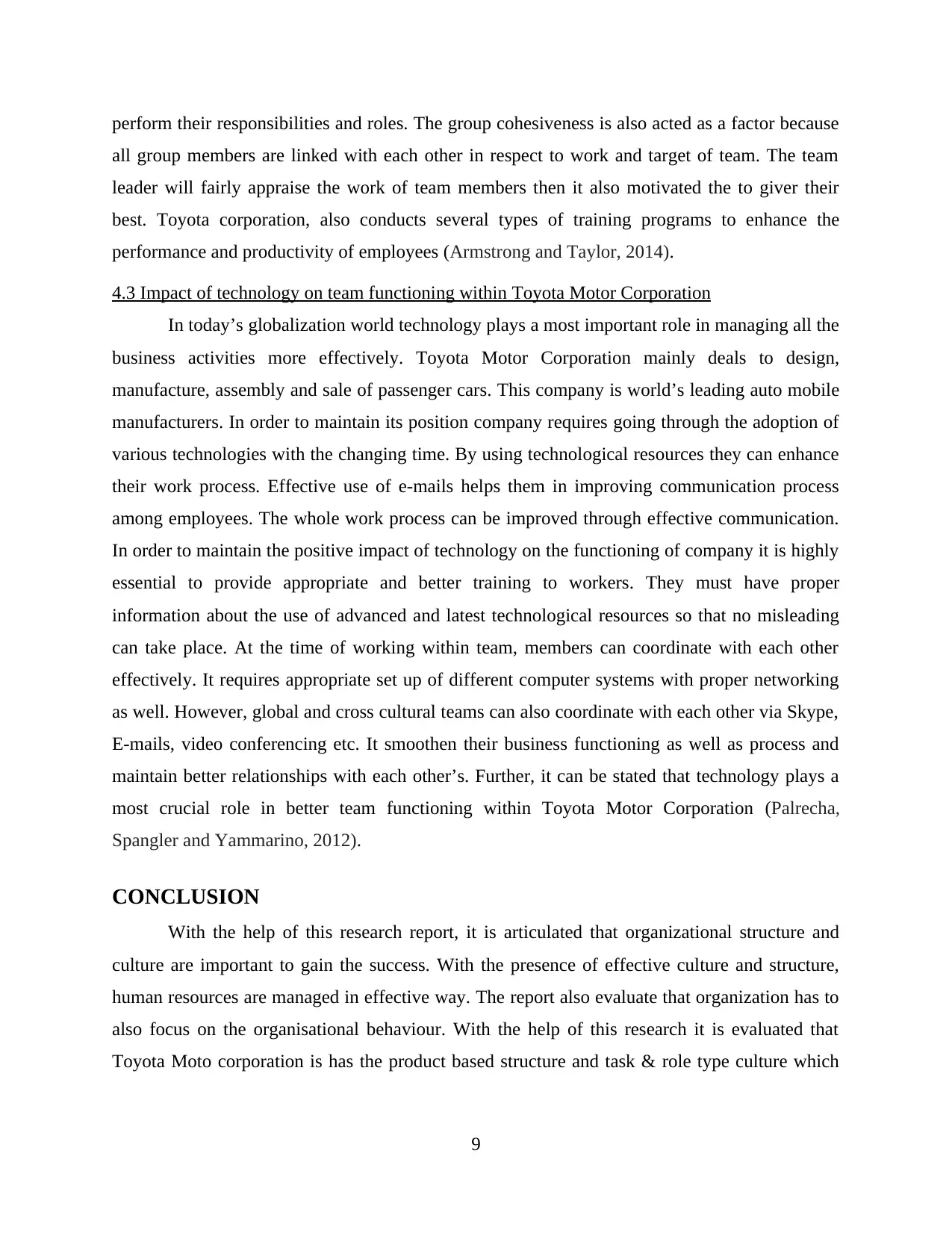
perform their responsibilities and roles. The group cohesiveness is also acted as a factor because
all group members are linked with each other in respect to work and target of team. The team
leader will fairly appraise the work of team members then it also motivated the to giver their
best. Toyota corporation, also conducts several types of training programs to enhance the
performance and productivity of employees (Armstrong and Taylor, 2014).
4.3 Impact of technology on team functioning within Toyota Motor Corporation
In today’s globalization world technology plays a most important role in managing all the
business activities more effectively. Toyota Motor Corporation mainly deals to design,
manufacture, assembly and sale of passenger cars. This company is world’s leading auto mobile
manufacturers. In order to maintain its position company requires going through the adoption of
various technologies with the changing time. By using technological resources they can enhance
their work process. Effective use of e-mails helps them in improving communication process
among employees. The whole work process can be improved through effective communication.
In order to maintain the positive impact of technology on the functioning of company it is highly
essential to provide appropriate and better training to workers. They must have proper
information about the use of advanced and latest technological resources so that no misleading
can take place. At the time of working within team, members can coordinate with each other
effectively. It requires appropriate set up of different computer systems with proper networking
as well. However, global and cross cultural teams can also coordinate with each other via Skype,
E-mails, video conferencing etc. It smoothen their business functioning as well as process and
maintain better relationships with each other’s. Further, it can be stated that technology plays a
most crucial role in better team functioning within Toyota Motor Corporation (Palrecha,
Spangler and Yammarino, 2012).
CONCLUSION
With the help of this research report, it is articulated that organizational structure and
culture are important to gain the success. With the presence of effective culture and structure,
human resources are managed in effective way. The report also evaluate that organization has to
also focus on the organisational behaviour. With the help of this research it is evaluated that
Toyota Moto corporation is has the product based structure and task & role type culture which
9
all group members are linked with each other in respect to work and target of team. The team
leader will fairly appraise the work of team members then it also motivated the to giver their
best. Toyota corporation, also conducts several types of training programs to enhance the
performance and productivity of employees (Armstrong and Taylor, 2014).
4.3 Impact of technology on team functioning within Toyota Motor Corporation
In today’s globalization world technology plays a most important role in managing all the
business activities more effectively. Toyota Motor Corporation mainly deals to design,
manufacture, assembly and sale of passenger cars. This company is world’s leading auto mobile
manufacturers. In order to maintain its position company requires going through the adoption of
various technologies with the changing time. By using technological resources they can enhance
their work process. Effective use of e-mails helps them in improving communication process
among employees. The whole work process can be improved through effective communication.
In order to maintain the positive impact of technology on the functioning of company it is highly
essential to provide appropriate and better training to workers. They must have proper
information about the use of advanced and latest technological resources so that no misleading
can take place. At the time of working within team, members can coordinate with each other
effectively. It requires appropriate set up of different computer systems with proper networking
as well. However, global and cross cultural teams can also coordinate with each other via Skype,
E-mails, video conferencing etc. It smoothen their business functioning as well as process and
maintain better relationships with each other’s. Further, it can be stated that technology plays a
most crucial role in better team functioning within Toyota Motor Corporation (Palrecha,
Spangler and Yammarino, 2012).
CONCLUSION
With the help of this research report, it is articulated that organizational structure and
culture are important to gain the success. With the presence of effective culture and structure,
human resources are managed in effective way. The report also evaluate that organization has to
also focus on the organisational behaviour. With the help of this research it is evaluated that
Toyota Moto corporation is has the product based structure and task & role type culture which
9
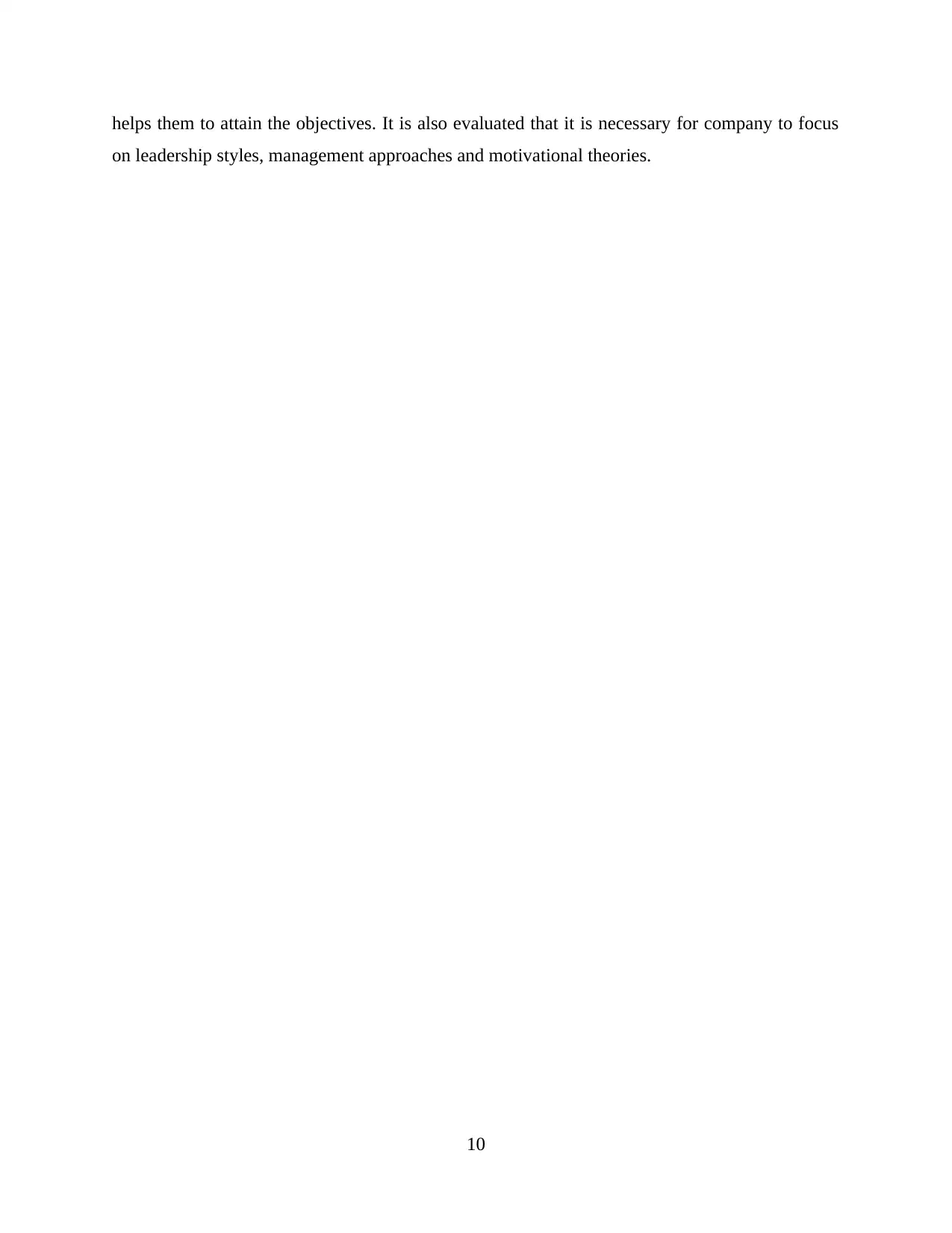
helps them to attain the objectives. It is also evaluated that it is necessary for company to focus
on leadership styles, management approaches and motivational theories.
10
on leadership styles, management approaches and motivational theories.
10
⊘ This is a preview!⊘
Do you want full access?
Subscribe today to unlock all pages.

Trusted by 1+ million students worldwide
1 out of 14
Related Documents
Your All-in-One AI-Powered Toolkit for Academic Success.
+13062052269
info@desklib.com
Available 24*7 on WhatsApp / Email
![[object Object]](/_next/static/media/star-bottom.7253800d.svg)
Unlock your academic potential
Copyright © 2020–2025 A2Z Services. All Rights Reserved. Developed and managed by ZUCOL.





